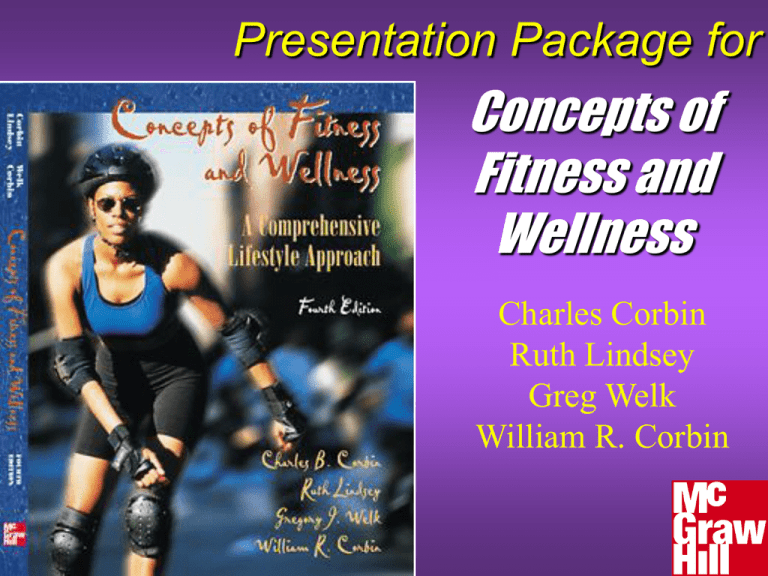
Presentation Package for
Concepts of
Fitness and
Wellness
Charles Corbin
Ruth Lindsey
Greg Welk
William R. Corbin
The Use and Abuse
of Alcohol
Some graphics from:
All rights reserved
Concepts of Fitness and Wellness
Use and Abuse of
Alcohol
Concepts of Fitness and Wellness
Health Consequences of
Alcohol Use
Increased risk of cardiovascular diseases
(Coronary Heart Disease, Stroke, Hypertension)
Increased risk of cancer:
(liver, stomach, colon, pancreas, breast, mouth, throat)
Impaired immune system
Malnutrition
Reproductive problems
Click here for info
from Nat. Institute of
alcohol abuse and
Alcoholism
Concepts of Fitness and Wellness
Behavioral Consequences
of Alcohol Use
Contributes to 50% of all
motor vehicle fatalities
Contributes to unsafe sex
and increased risk of AIDS
Contributes to risky behavior
and accidental death
Click here for info
from MADD site
Concepts of Fitness and Wellness
Social Consequences of
Alcohol Use on Campus
80% of campus vandalism
involved alcohol
70% of violent behavior on
campus involved alcohol
75% of men and 55% of women
involved in acquaintance rape were
under the influence of alcohol
Click here for info from the Higher
Education Center for Alcohol and
Other Drug Prevention
Concepts of Fitness and Wellness
Academic Consequences
of Alcohol Use
40% of poor academic performance at
college has been linked to drinking
7% of first year dropouts are
related to alcohol
Alcohol intake is inversely
related to GPA
Concepts of Fitness and Wellness
Rates of Drinking on College Campuses
(Data from 17,542 students from 140 Colleges)
MEN
15%
35%
50%
Non-drinkers
Occasional Drinker
Binge Drinker *
Source: Weschler, H. et al.,
JAMA 272(21):1672-1677, 1994.
WOMEN
16%
45%
39%
* Binge drinking was defined
as having 5 drinks in a row at
least once every 2 weeks.
See Web21-2 for more information
about drinking rates on campuses
Concepts of Fitness and Wellness
Attitudes and Perceptions
toward Alcohol on Campus
95% of students believe that the
average student drinks alcohol weekly
30% of students indicated they would
prefer NOT to have alcohol at parties
Web21-3
Concepts of Fitness and Wellness
Why People Start Drinking
Peer pressure
Need to belong and be accepted
Media depiction of drinking
Easy access (often at home)
Absence of religious attachment
Cultural / sociological traditions
Social "lubrication"
Makes one "feel good"
Concepts of Fitness and Wellness
Alcohol Content in Drinks
All three have the
same alcohol content
despite different volumes
Beer: 4% alcohol X 12 oz
alcohol
Wine: 12% alcohol X 4 oz
alcohol
=
.48 oz
=
.48 oz
Concepts of Fitness and Wellness
Lab 21a
information
Factors Determining the
Effects of Alcohol
How much was consumed
Rate of consumption
What is in stomach
Presence of carbonation
Mood status
Sex
Concepts of Fitness and Wellness
Rate of Alcohol Removal
Liver can process .25 oz of alcohol per
hour (2 hours to process one drink)
Blood Alcohol Content (BAC) decreases
by about .015% per hour
Concepts of Fitness and Wellness
Lab 21b
information
Steps to Being a
Responsible Drinker
Limit number of drinks
Drink less than 1 per 90 min.
Sip slowly
Eat lots of protein/starch
Avoid carbonated drinks
Measure drinks carefully
Don't drive if intoxicated
Concepts of Fitness and Wellness
How to Help a Friend with a
Drinking Problem
Plan a time to talk with person about it
Confront behavior - not the individual!
Use "I" not "you" in statements
Don't judge, blame or lecture
Be genuine, kind, and honest
Be prepared for denial or rejection
Have referral resources available
Concepts of Fitness and Wellness
Web Resources
Alcoholics Anonymous - http://www.alcoholics-anonymous.org
The Century Council – www.centurycouncil.org
Higher Education Center for Alcohol and Other Drug Prevention
(Department of Education) – www.edc.org/hec
National Clearinghouse for Alcohol and Drug Information
(NCADI) - www.health.org
National Institute on Alcohol Abuse and Alcoholism http://www.niaaa.nih.gov
Mothers Against Drunk Driving (MADD) - http://www.madd.org/
Concepts of Fitness and Wellness
Return to
presentation
Lab 21a Information
Blood Alcohol Levels
Go through calculations to estimate
your blood alcohol content.
Discuss whether you were surprised by
the figures and whether it may influence
your drinking behavior.
Concepts of Fitness and Wellness
Return to
presentation
Lab 21b Information
Self-Perceptions of Alcohol Use
Evaluate the drinking behavior of
yourself or a person close to you.
How would you classify yourself or your
friend regarding drinking behavior.
Would others view you or your friend
the same way?
Concepts of Fitness and Wellness
Supplementary Graphics
Concepts of Fitness and Wellness








